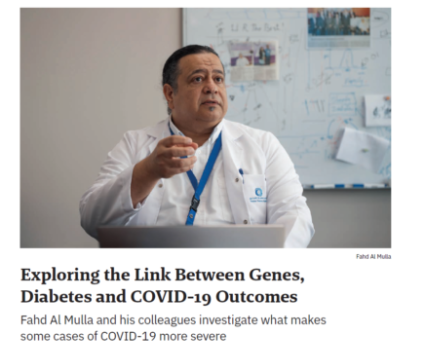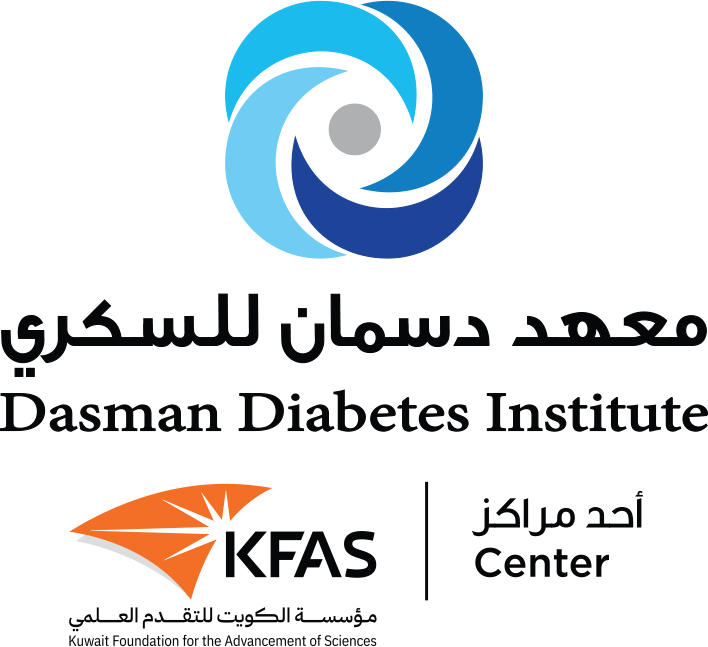
Exploring the Link Between Genes, Diabetes and COVID-19 Outcomes
Published on 05/07/2021
Prof. Fahd Almulla and his colleagues investigate what makes some cases of COVID-19 more severe.
A striking feature of COVID-19 has been the variability in outcome, which ranges from silent infection in some patients to fatality in others, as well the ‘long COVID’ that afflicts some. This variability isn’t surprising for a new disease rapidly spreading through a diverse population but understanding what underpins it would be invaluable in figuring out how to cope with the pandemic and mitigate its impact. Although COVID-19 infections are more likely to be severe in older people, males, and those with underlying medical conditions, these factors alone do not account for the immense variability in outcomes. An international team of scientists hypothesized that the development of life-threatening COVID-19 might be linked with inborn mutations in immune-related genes in some patients. They established an international consortium known as the COVID Human Genetic Effort to test this hypothesis.
This idea has a natural appeal to genomics researcher Fahd Al Mulla of Dasman Diabetes Institute, who has always seen a clear link between diseases and malfunctioning molecules and molecular pathways in diseases. When he and his colleagues heard about the consortium, they were eager to join. “Real success happens in collaboration,” he said. The consortium was keen to bring their expertise on board. Over the past few years, Al Mulla has done significant work to improve the state of genomics data about the Kuwaiti population. To figure out which of the millions of genetic variations in each human genome might be linked to a condition — such as susceptibility to severe COVID-19 — scientists use statistical analyses that detect correlations between rare variants and the condition they’re studying. However, for this to work, the reference data has to reflect the diversity of human populations. Most genomics data come from people of European descent, but variants that are rare in those populations could be common elsewhere.
By sequencing the genomes of Kuwaitis, Al Mulla has been part of the global effort to redress that imbalance. Using a combination of microarrays and high-throughput sequencing, he has collected genomic data from healthy Kuwaitis and Kuwaitis with chronic health conditions, and the genome sequences are paired with well-characterized medical histories. Using these tools, he has investigated the genomics of cancer and diabetes in the Kuwaiti population, testing how well results from elsewhere can be applied locally. “We need to study the variation in different populations,” he said. “We need to study and understand ways to apply genomic medicine not just in US or Arab or Chinese populations but in all of them, and to do that we need a database that captures all the variation.” Diversity in genomic data is especially important when looking for differences in the response to global diseases such as COVID-19.
The consortium analyzed data from 659 patients with life-threatening COVID-19, including people from Asia, Europe, Latin America and the Middle East. The researchers wanted to test whether life-threatening pneumonia from COVID-19 was associated with mutations in three immune genes that are known to be linked with life-threatening influenza pneumonia. They also included ten more loci which are directly connected to the three core genes and have been linked with other viral infections. By comparing these genomes with those of 534 people with mild or asymptomatic COVID-19, the team identified 118 genetic variants that were more common in patients with severe COVID-19. Experiments showed that most had no significant effect on the function of the gene, but 24 had a deleterious effect. These variants were spread across eight of the thirteen loci tested, leading the researchers to conclude that defects in these genes make a person more likely to develop a severe case of COVID-19 if they get infected.
Next, the team tested cells from the patients with these genotypes to see how they would react to infection by SARS-CoV-2, the virus responsible for COVID-19. The patients tested had a mutation in one of the core genes, IRF7, and, as expected, their T-cells had low expression levels of this gene. When exposed to SARS-CoV-2, these cells fail to produce interferons, a type of signaling molecule released in response to viral infections to activate the immune system, and the mutant cells also had higher infection levels than healthy cells. These defects could be corrected by engineering the cells to express the wild-type version of the gene.
The researchers found similar results in cells with a mutation in another gene, INAR1. While IRF7 is associated with both type I and type III interferons, changes in INAR1 only affect type I interferons. The researchers measured type I interferon levels in the blood of their patients and found that ten of them had very low levels during the acute phase of COVID-19. Altogether, these results point towards an important role for type I interferons in the response to COVID-19. “What we realized is that many of the cases of severe COVID-19—people who are dying from the disease—are because of variation in the interferon genes which produces inefficient interferons,” said Al Mulla. One implication of this is that administering type I interferons may be a valuable therapeutic tool in some COVID-19 patients. Al Mulla is also interested in factors besides genetics that drive COVID-19 outcomes. Collaborating with Hamad Ali, his colleague at Dasman Diabetes Institute, Al Mulla has been investigating the link between fasting blood glucose levels and COVID-19 severity. Hyperglycemic patients face a greater susceptibility to infections and complications in general, and diabetes is associated with an increased risk of severe COVID-19. To date, analyses of the link between the two have incorporated blood glucose either as discrete categories (such as high or low based on a threshold) or as a linear variable. Both approaches are rough approximations that can obscure important information. The former introduces a dramatic change when glucose levels cross the threshold, while the latter treats all changes in blood glucose levels equivalently.
By fitting a smoothly varying curve to the relationship between blood glucose levels and ICU admittance from COVID-19, the new study captures nuances that were missed by earlier approaches. They showed that even a small increase within the normal range of fasting blood glucose was associated with a substantial increase in risk of ICU admission for COVID-19 patients. “This difference can’t be overlooked clinically, and it demonstrates the need to strictly monitor glucose levels upon admission,” said Ali. The researchers hypothesized that the mechanism linking glucose levels with COVID-19 outcomes may change as glucose levels increase, shifting from energy metabolism affecting viral replication at low glucose levels to chronic inflammation disrupting the immune response at higher levels. Based on these analyses, Al Mulla and Ali, together with Mohamed Abu-farha and Thamer Alessa, have launched a clinical trial of the insulin sensitizer pioglitazone as a treatment for moderate or severe COVID-19. The results so far are very promising, said Al Mulla, who is eager to see more people take part in the trial, “This is phenomenal progress in our fight against COVID-19. We are saving lives.”


